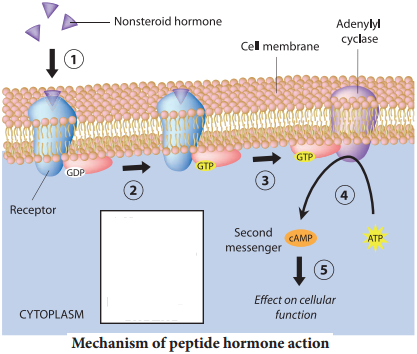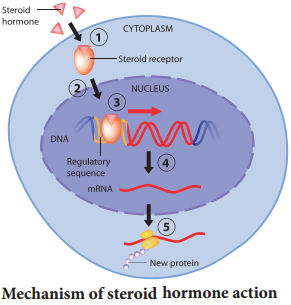Learninsta presents the core concepts of Biology with high-quality research papers and topical review articles.
Mechanism of Hormone Action
Hormones circulate in the blood but their concentration can increase or decrease based on the requirement of the body. This is controlled by feedback mechanisms. These mechanisms control the secretion of endocrine glands by stimulating the hypothalamus, pituitary or both, which inturn governs the secretion of a particular hormone.
In positive feedback, the secretion of the hormone increases where as in negative feedback further secretion of hormone slows down. Feedback mechanisms are the key factors for maintaining homeostasis in our body.
Hormones are classified into three major groups as peptide hormones, steroid hormones and amino acid derived hormones based on their chemical structure.
Peptide hormones cannot cross the phospolipid cell membrane and bind to the receptors on the exterior cell surface. They are are transported to the golgi, which is the site of modification. It acts as a first messenger in the cell. Hormones on binding to their receptors do not enter the target cell but generate the production of second messengers such as cyclic AMP (c AMP), which in turn regulates cellular metabolism.
This is catalyzed by the enzyme adenylate cyclase. The interaction between the hormone at the surface and the effect brought out by cAMP within the cell is known as signaling cascade. At each step there is a possibility of amplification. (Figure 11.17)

- One hormone molecule may bind to multiple receptor molecules before it is degraded.
- Each receptor may activate several adenylate cyclases each of which make much cAMP.
- Thus there is more signal after each step.
The actions of cAMP are terminated by phosphodiesterases. The effect of peptide hormones like insulin, glucagon, somatotropin are usually short lived because they work through second messenger system.
Steroid hormones can easily cross the cell membrane, and bind to their receptors, which are intracellular or intranuclear. Upon binding to the receptors, they pair up with another receptor – hormone complex (dimerize). This dimer can then bind to DNA and alter its transcription. (Figure 11.18)

The effect of steroid hormones such as aldosterone, oestrogen, FSH are long lived, as they alter the amount of mRNA and protein in a cell. Amino acid derived hormones are derived from one or two aminoacid with a few additional modifications. Thyroid hormone is synthesised from tyrosine and includes the addition of several iodine atoms.
Epinephrine an amino acid derivative may function through second messenger system like peptide hormones or they may actually enter the cell and function like steroid hormones.
Hormones activate target cells by diffusing through the plasma membrane of the target cells (lipid-soluble hormones) to bind a receptor protein within the cytoplasm of the cell, or by binding a specific receptor protein in the cell membrane of the target cell (water-soluble proteins).
There are two modes of hormonal action. A: Activation of cell-surface receptors and coupled second-messenger systems, with a variety of intracellular consequences.
Hormone levels are primarily controlled through negative feedback, in which rising levels of a hormone inhibit its further release. The three mechanisms of hormonal release are humoral stimuli, hormonal stimuli, and neural stimuli.
This type of mechanism is shown by lipid soluble hormones such as fatty acids and steroids that can easily pass through the plasma membrane. They possess intracellular receptors. The hormones bind to the target receptor that activates the enzymatic activity of the cell to bring about biochemical changes.
Mechanism of hormone action is not the same in all categories of hormones is a proteinaceous hormone, has large molecular weight and is insoluble in lipids, therefore, it cannot enter the target cell. Thus, it binds with the membrane bound receptor present on ovarian cell membrane.
The action involves secretion of by the thyroid gland into the circulation, uptake of target tissues, activation or inactivation of by deiodinase enzymes, binding of to nuclear receptors that act as ligand-regulated transcription factors, and regulation of expression of target genes.
What is the most common mechanism of hormone control? With negative feedback, the most common mechanism of hormone control, some feature of hormone action directly or indirectly inhibits further hormone secretion so that the hormone level returns to an ideal level or set point.
Hormones bind to specific proteins (hormone receptors) in the target tissues and produce effect on them. There are two types of receptors: membrane bound receptors (hormone receptors present on the cell membrane of the target cell) and intracellular receptors (receptors present inside the target cell).
The mechanism by which peptide hormones act upon specific target tissues to evoke characteristic functional responses is believed to be initiated by interaction with a highly special- ized portion of the plasma membrane, the so called hormone receptor site.